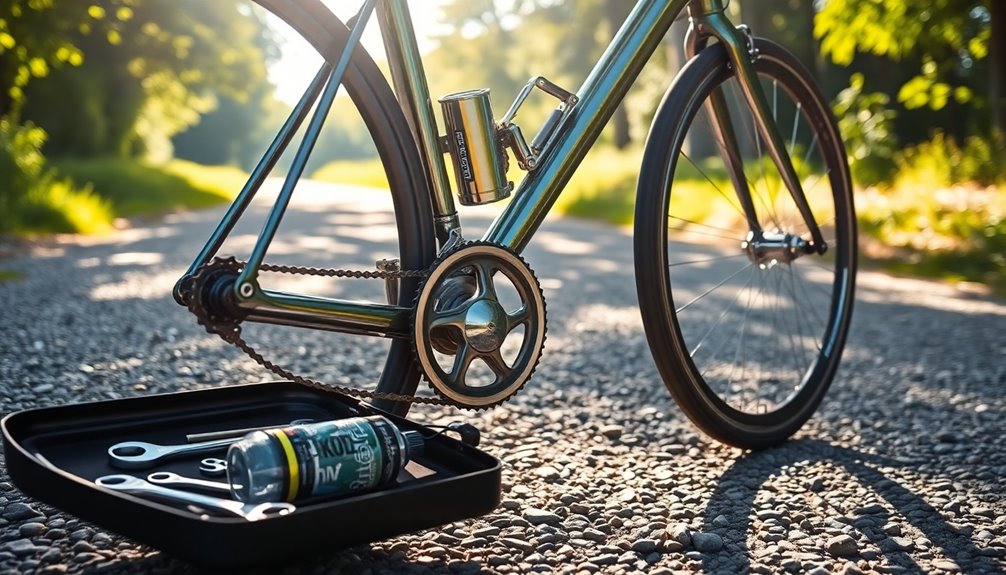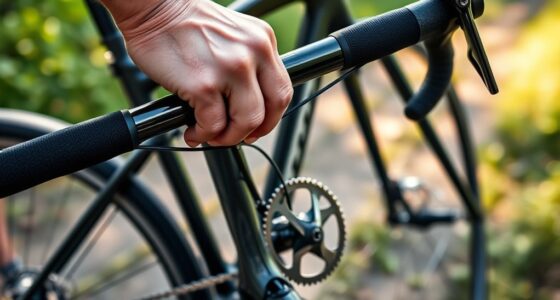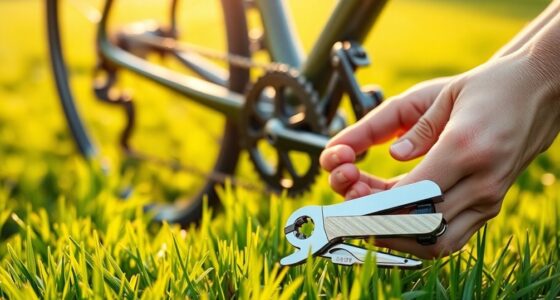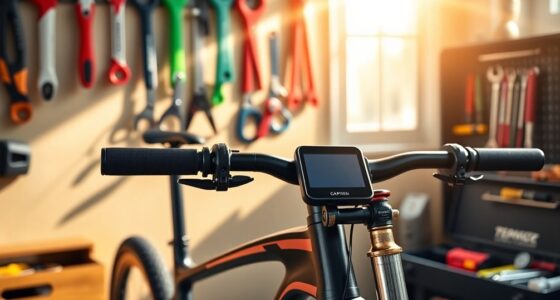To prepare your bike for long-distance rides, start with a thorough inspection of the frame, tires, brakes, and gears, tightening any loose bolts. Verify your tire pressure is ideal and check for wear. Clean and lubricate the chain for smooth performance. Carry essential tools like spare tubes and a pump for emergencies. Don't forget to schedule professional servicing every 1,000 miles to maintain efficiency. Keep going to find even more tips for a successful ride!
Key Takeaways
- Conduct a thorough inspection of the bike, checking the frame, tires, chain, brakes, and gears for any issues before the ride.
- Ensure tires are properly inflated to the recommended PSI and inspect for wear or damage to maximize performance and avoid flats.
- Clean and lubricate the chain to ensure smooth shifting and prevent wear during long rides; lubricate every 100-200 miles as needed.
- Carry essential tools such as a spare inner tube, portable pump, and multitool for quick repairs and adjustments on the road.
- Schedule professional servicing in advance to address any mechanical issues, ensuring the bike is in peak condition for long-distance rides.
Inspecting Your Bike
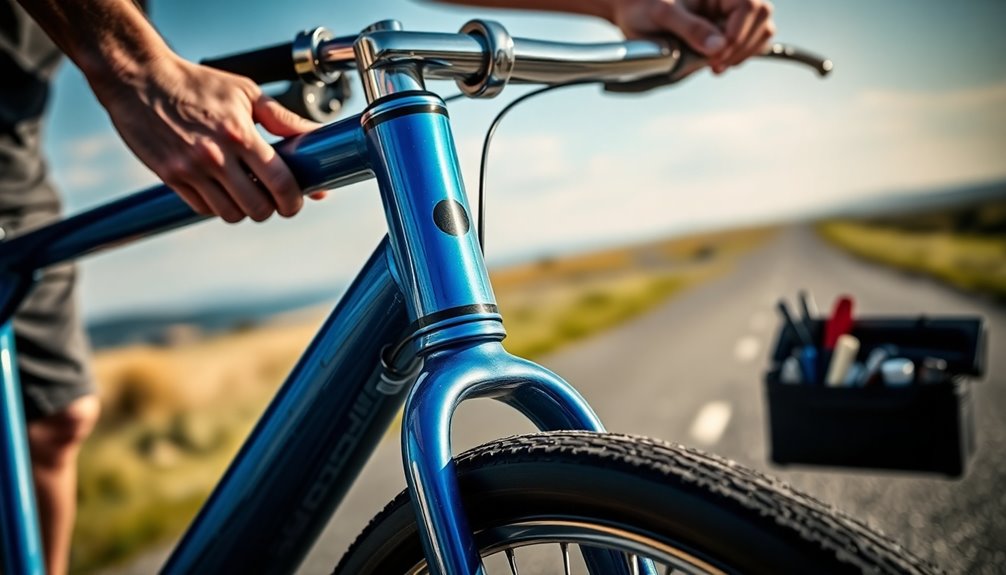
Before you hit the road for a long-distance ride, it's crucial to inspect your bike thoroughly.
Start by checking your tires for wear, making sure they're free of cracks or punctures and inflated to the recommended PSI.
Check your tires for wear, ensuring they are free from cracks or punctures and properly inflated to the recommended PSI.
Next, examine the chain for rust or signs of wear; apply lubricant as needed for smooth shifting.
Don't forget to check your brake pads—replace them if they're worn down to maintain safe stopping power.
Assess the frame and components for any damage or looseness, tightening bolts to secure everything.
Finally, test the gears by shifting through all settings to confirm they engage smoothly without skipping or grinding.
Regular maintenance of these key areas guarantees a safe and enjoyable ride.
Ensuring Proper Tire Maintenance
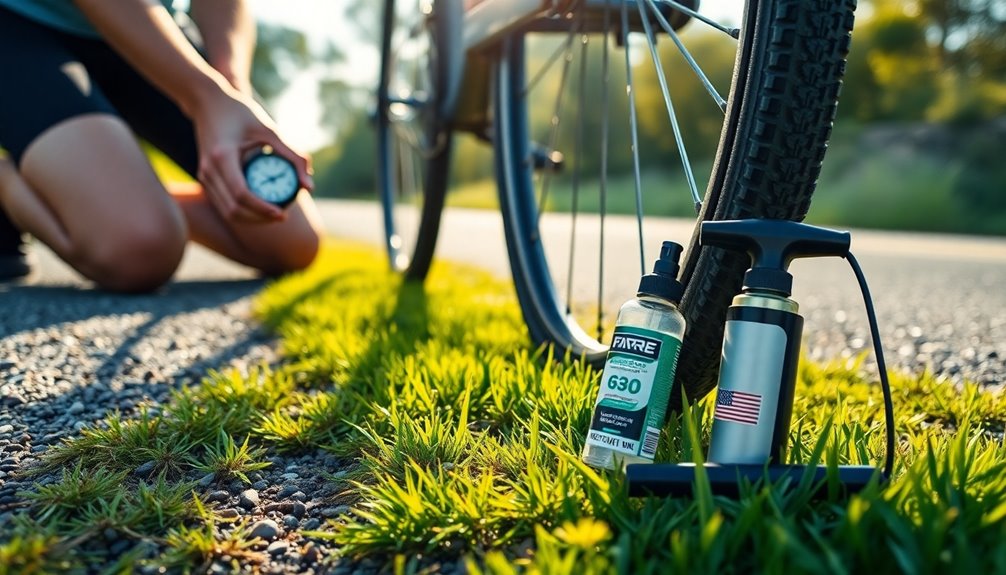
To keep your bike in top shape for long-distance rides, you need to regularly check your tire pressure and inspect for any wear patterns.
If you notice any signs of damage or uneven wear, it might be time to replace your tires.
Staying on top of these maintenance tasks guarantees a smoother and safer ride.
Check Tire Pressure Regularly
Regularly checking your bike's tire pressure is essential for ensuring a smooth and efficient ride. Proper tire pressure is vital for long-distance riding, as under-inflated tires can increase rolling resistance, decreasing your efficiency by up to 20%.
Before each cycling journey, make sure your tire pressure aligns with the manufacturer's specified PSI range found on the tire sidewall. For road bikes, this usually falls between 80 to 130 PSI, while touring or mountain bikes should be between 30 to 50 PSI.
Investing in a reliable pressure gauge is a smart move, as even minor deviations can affect handling and comfort. Regular maintenance of tire pressure will help you avoid unexpected issues and enjoy a safer ride.
Inspect for Wear Patterns
Checking your tire pressure sets the stage for effective tire maintenance, but it's equally important to inspect your tires for wear patterns. Regularly checking for uneven tread, cracks, or bald spots can greatly impact your bike's performance and safety.
| Wear Pattern | Impact on Performance |
|---|---|
| Uneven Tread | Poor grip and handling |
| Cracks | Increased risk of blowouts |
| Bald Spots | Reduced traction |
| Sidewall Cuts | Weakened tire structure |
Make it a habit to monitor your tires before long rides. Rotate them regularly to promote even wear, and remember that maintaining your tires is vital for a safe, enjoyable journey. Don't overlook the details; your safety depends on it!
Replace Tires When Needed
Maintaining ideal tire performance is essential for long-distance rides, and knowing when to replace your tires can make all the difference.
Regularly inspect your tires for signs of wear like cracks, bulges, or worn tread. Replace them if the tread depth drops below 1.5mm to guarantee peak grip and performance.
Always inflate your tires to the manufacturer's recommended PSI; under-inflated tires can increase rolling resistance and lead to faster wear or flats.
Keep in mind the terrain you'll ride on; choose wider tires for rough paths and narrower ones for smooth roads.
Even if your tires look fine, replace them every 2-5 years due to rubber degradation.
Finally, keep spare tires or a repair kit handy to avoid disruptions.
Checking Brakes and Gears

Before you hit the road, you need to check your brakes and gears to guarantee a safe ride.
Start by evaluating your brake functionality and inspecting gear shifting, as both are essential for tackling long distances.
Don't forget to adjust cable tension if needed to keep everything running smoothly.
Brake Functionality Assessment
Verifying your bike's brakes and gears are in peak condition is essential for a safe and enjoyable long-distance ride.
Start by inspecting your brake pads for wear; you should have at least 1-2 mm of pad material left to maintain effective stopping power. Test the brake lever feel—brakes should engage smoothly without excessive travel. Check brake cables for fraying or corrosion, replacing any damaged ones to prevent failure.
Additionally, verify rotor alignment; they must be centered and not rubbing against the caliper to guarantee maximum brake functionality.
Finally, while stationary, cycle through each gear to confirm smooth gear shifting, making adjustments to the derailleurs if you notice any skipping. Your safety depends on these checks!
Gear Shifting Inspection
Once you've confirmed your brakes are functioning properly, it's time to focus on your bike's gear shifting.
Start by inspecting the shifters to verify smooth operation. Shift through all gears while stationary, checking for any skipping or sticking.
Next, pay attention to the derailleur. A misaligned derailleur hanger can lead to poor shifting performance.
Here are three key points to remember:
- Lubricate the chain regularly to prevent wear and verify efficient gear shifting.
- Check for wear on the chain; a worn chain can affect performance.
- Verify the derailleur is straight and aligned to avoid chain drops.
Cable Tension Adjustment
As you prepare for long-distance rides, checking the cable tension for both your brakes and gears is essential for peak performance.
Start with the brake cable: pull the brake lever and check the distance between the brake pads and the rim. They should engage when you squeeze the lever halfway.
For the gear cable, shift to the highest gear and verify the derailleur smoothly moves the chain across all sprockets. If it skips, an adjustment is needed.
Use a 5mm Allen wrench to turn the barrel adjuster—clockwise to tighten or counterclockwise to loosen the tension.
Regularly inspect cables for fraying or rust, and after adjustments, take a short ride to verify everything functions correctly before your long rides.
Lubricating the Chain

To keep your bike running smoothly on long-distance rides, regularly lubricating the chain is crucial. This prevents rust and guarantees peak performance. Aim to lubricate your bike chain every 100-200 miles, especially after wet rides.
Regularly lubricating your bike chain every 100-200 miles is essential for preventing rust and ensuring optimal performance.
Here are some key steps to follow:
- Clean the chain with a degreaser before applying lubricant to remove dirt and grime.
- Choose a quality bike-specific lubricant: dry lube for dry conditions and wet lube for muddy ones.
- Wipe off excess lubricant with a clean rag to prevent attracting dirt, which can cause further wear.
Don't forget to check your chain's wear regularly using a chain checker tool. If it exceeds 0.5%, consider replacing it to prolong your drivetrain's life.
Cleaning the Frame and Components
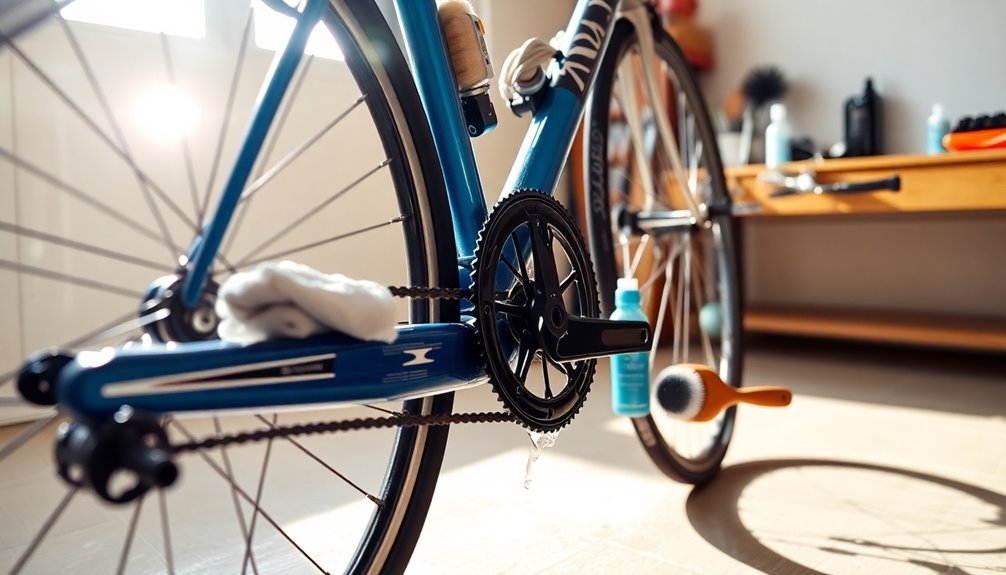
Keeping your bike clean is essential for maintaining its performance and longevity, especially before long-distance rides.
Start by using a bike-specific cleaner and a soft cloth or sponge to gently scrub the frame and components, removing dirt and grime without damaging the finish. Pay special attention to the drivetrain; dirt can hinder performance.
Use a degreaser on the chain, cassette, and derailleurs for smooth operation. After cleaning, rinse the bike thoroughly to eliminate soap residue, which attracts dirt and causes corrosion over time.
Dry it with a clean microfiber towel to prevent water spots and rust, particularly on metal parts.
Regularly inspect the frame for scratches or damage, as this helps identify potential issues needing repair before your journey.
Essential Tools to Carry

When heading out on a long-distance ride, having the right tools can make all the difference. You never know when you might face an issue, so packing essential repair tools is vital.
Here's what you should carry:
- Spare inner tubes and a patch kit for quick fixes on flat tires
- A portable bike pump or CO2 inflator to inflate tires after repairs
- A chain tool or quick-release chain link for any chain-related problems
Additionally, a multitool with various wrenches and screwdrivers will help you handle common adjustments.
Don't forget tire levers to make changing tires easier, especially if they fit tightly. Being prepared with these tools guarantees you can tackle any unexpected challenges on your ride.
Scheduling Professional Servicing
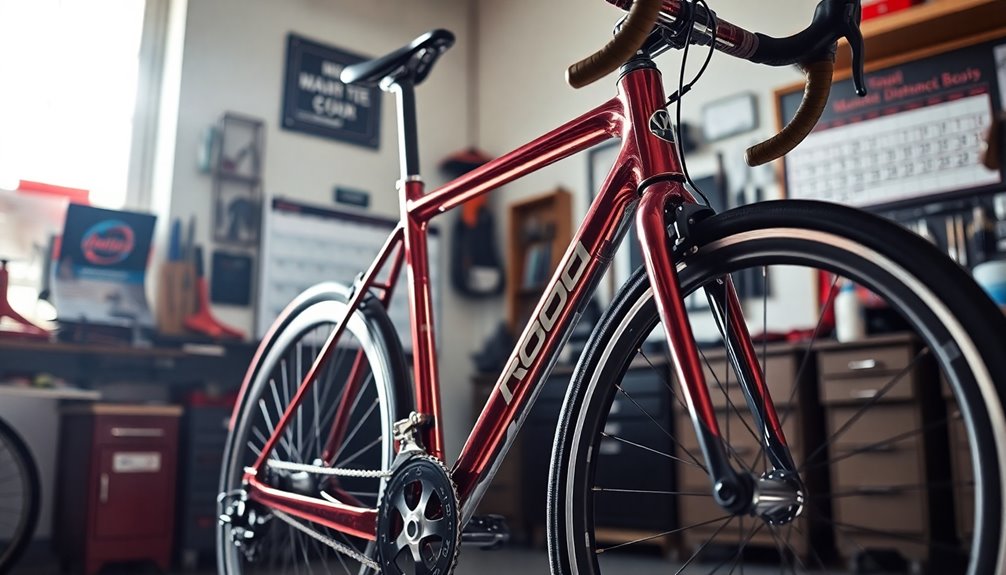
Scheduling professional servicing for your bike is vital, especially as you prepare for a long-distance ride. Aim to book this service a few weeks in advance to address any potential mechanical issues and guarantee peak bike performance.
A thorough check of the drivetrain, brakes, and tires will enhance your bike's efficiency and safety. Regular servicing every 1,000 miles or at least twice a year is important for maintaining reliability, depending on your usage.
During the service, mechanics can recommend specific upgrades or adjustments to improve your comfort on long rides. Keeping a record of your bike's service history helps track maintenance needs and spot patterns that may indicate underlying issues.
Mechanics can suggest upgrades for comfort on long rides, while tracking service history helps identify maintenance patterns.
Prioritize this step to guarantee a smooth journey!
Frequently Asked Questions
How to Prepare a Bike for a Long Ride?
To prepare your bike for a long ride, start by checking its size and fit; adjustments to the saddle height and handlebars can make a big difference in comfort.
Inspect your tires for wear and guarantee proper PSI, then test the brakes.
Clean and lubricate the drivetrain for smooth shifting.
Finally, pack essential repair tools like spare tubes and a pump, so you're ready for any unexpected issues on the road.
How to Prepare for a Very Long Bike Ride?
You might think you can just hop on your bike and ride for hours, but that'll lead to discomfort or worse.
Preparing for a very long bike ride means checking your gear, testing your clothing, and ensuring your bike's in top shape.
Pack enough hydration and snacks to fuel your journey, and carry essential tools for unexpected issues.
With the right preparation, you'll enjoy the ride and tackle those miles with confidence.
Is It Realistic to Bike 20 Miles a Day?
Yes, it's realistic to bike 20 miles a day, especially if you gradually build your endurance.
Start with shorter distances and increase them by about 10% each week. Most cyclists can complete 20 miles in 1.5 to 2 hours, depending on fitness and terrain.
Just remember to include rest days, stay hydrated, and fuel your body properly.
Setting specific goals and tracking your progress will help keep you motivated along the way.
How to Plan Long Distance Cycling?
To plan long-distance cycling, start by setting a SMART goal that outlines your distance and timeline.
Gradually increase your mileage each week by about 10% to build endurance.
Choose routes that match your fitness level, considering factors like terrain and weather.
Don't forget to plan your nutrition and hydration, aiming for 30-60g of carbs per hour during rides.
Finally, share your goals with friends for motivation and accountability.
Conclusion
By taking these steps to prepare your bike, you're not just getting ready for a ride; you're setting the stage for an adventure that echoes the journeys of great explorers. Just as they checked their maps and packed their supplies, you'll guarantee your bike's in top shape, ready to conquer the open road. So, gear up, embrace the thrill of the ride, and let the wind guide you toward new horizons. Your adventure awaits!
